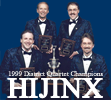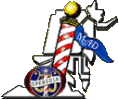The barbershop style can be viewed as having two major components: technical and artistic.
The technical aspects of the style relate to those elements that define the style regardless of how well it's performed.
The artistic aspects relate to those performance aspects that are equally essential to the style's preservation.
A. Technical (Structural) Aspects
- Barbershop harmony is a style of unaccompanied vocal music characterized by consonant four-part chords for every melody note in a primarily homorhythmic texture. The melody is consistently sung by the lead, with the tenor harmonizing above the melody, the bass singing the lowest harmonizing notes, and the baritone completing the chord. Occasional brief passages may be sung by fewer than four voice parts.
- Barbershop music features songs with understandable lyrics with melodies that clearly define a tonal center and imply major and minor chords and barbershop (dominant and secondary dominant) seventh chords that often resolve around the circle of fifths, while also making use of other resolutions. The chords are almost always in root position or second inversion, with a predominance of barbershop sevenths and major triads.
B. Artistic (Performance) Aspects
- Barbershop singers adjust pitches to strive for perfectly tuned chords in just intonation, while remaining true to the established tonal center. When chords are sung in tune with matched and resonant sounds, a “lock and ring” results. Locking, ringing chords are the hallmark of the barbershop style.
- The use of similar word sounds sung in good quality and with precise synchronization, as well as optimal volume relationships of the voice parts, creates a unity that helps produce the most desirable barbershop sound.
- The barbershop style is typified by natural, resonant, full-voiced singing, though tenors may be singing not in full voice.
- Performers have the freedom to bring a variety of styles, interpretations, and performance preferences to the stage.
- Performers should strive to present the song to the audience in an authentic, sincere, and heartfelt manner.
- The music and the performance of the music must reflect the fact that barbershop music features relatively straightforward, ingenuous songs, sung from the heart, that are easily understandable to the audience. The delivery should be believable and sensitive to the song and arrangement throughout.
- Barbershop music typically has a balanced and symmetrical form. As long as these are recognizable, the performer is free to be creative within the forward motion of the music.
- Arrangements in the barbershop style use various embellishments. The devices chosen, as well as their performance, should support and enhance the song.
- The performance of barbershop music features appropriate musical and visual methods to enhance and support the song and provide the audience with an emotionally satisfying, entertaining experience.
- Barbershop groups are free to employ a wide variety of dramatic staging plans, interpretive or staging devices, postures, motions, props or standing formations, as long as these do not detract from the barbershop sound and are appropriate to the song.
- A song may have a simple or complex setting and still be in the barbershop style. Performers are encouraged to choose music that they enjoy singing and that features the strengths and minimizes the weaknesses of the ensemble.
|




